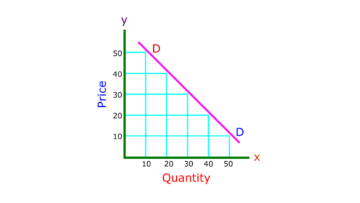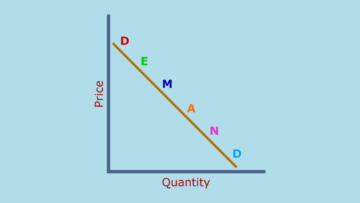The law of demand is a very important concept of demand and economics because it helps in understanding the relationship between price and commodity. According to the law of demand, whenever the price of a commodity decreases, the demand for that commodity increases, similarly, whenever the price of a commodity increases, the demand for that commodity decreases but the condition is that all other things remain the same.
The law of demand applies only when all other things remain the same, If the demand increases or decreases due to any reason other than the price of the product then it will not come under the law of demand because the law of demand is applicable only when the assumptions of the law of demand are fulfilled.

Table of Contents
Law of demand
Meaning of law of demand
The law of demand shows the relationship between price and commodity, according to this, there is an inverse relationship between demand and price because when the price of a commodity increases, the demand for that commodity decreases, and similarly when the price of a commodity decreases, the demand for that item increases.
The main reason for the inverse relationship between demand and price is the increase or decrease in purchasing power because if the price decreases then the purchasing power automatically increases, similarly if the price increases then the purchasing power automatically decreases. For example, if the price of milk increases then the demand for milk decreases due to purchasing power, similarly when the price of milk decreases then the demand for milk increases due to purchasing power.
Definition of law of demand
According to – Marshall – ” The law of demand states that amount demanded increases with a fall in price and diminished when price increases. “
According to Prof. Samuelson – “Law of Demand states that people will buy more at lower prices and buy less at higher prices, if other things remaining the same.”
According to Lipsey – “A fall in the price of a commodity causes the household to buy more of that commodity and less of the other commodities which complete with it, while rise in prices causes the household to buy less of this commodity and more of competing commodities.”
According to Benham – “Usually a larger quantity of commodity will demanded at lower price that a higher price.”
Explanation of the law of demand

Explanation of table: The above table shows that when the price of the commodity is 50 rupees then the quantity demanded is 10 units, similarly when the price of the commodity decreases to 10 rupees then the quantity demanded is 50 units.

Explanation of graph: Y axis is showing the price of the good and X axis is showing the quantity demanded by the consumer. The above graph shows that when the price of the commodity is 50 rupees then the quantity demanded is 10 units, similarly when the price of the commodity decreases to 10 rupees then the quantity demanded is 50 units.
Assumptions of the law of demand
Following are the assumptions of the law of demand:
- No change in consumer’s income.
- No change in consumer habits and tastes.
- No change in prices of substitute goods.
- No change in government policy.
- No change in climatic conditions.
- No change in number of consumers.
- No expectation of change in prices of commodities in future etc.
Why the slope of the demand curve is downward?
There are many reasons for the downward slope of the demand curve, some of them are as follows:
1. Law of Diminishing Marginal Utility:
The law of diminishing marginal utility tells us that if a consumer uses more and more quantity of the same good, the consumer’s interest in those good decreases. For example, if a consumer eats mango for the first time, he will get more satisfaction. Similarly, if he eats mango for the second time, he will get less satisfaction than the first time.
2. New Consumers:
When the price of a product decreases, some consumers who were not able to buy it earlier due to the high price can now buy it.
3. Substitution Effect:
When the price of a related good decreases, the consumer is shown more interest in that good. Like, Coca-Cola and Pepsi etc.
4. Income Effects:
Income effect means that when a consumer’s income increase, he demands more goods than before. For example, if a person’s income was earlier Rs 100, he used 50 units and now his income has increased to Rs 200 then he can use 100 units.
5. Different Uses:
There are some things which have different uses. For example, milk is used in making tea, coffee, cheese, curd etc. If the price of milk increases, the consumer will use it limitedly and when its price decreases, the consumer will use it unlimitedly.
Read also:
QNA/FAQ
Q1. What is the law of demand?
Ans: The law of demand shows the relationship between price and commodity, according to this, there is an inverse relationship between demand and price because when the price of a commodity increases, the demand for that commodity decreases, and similarly when the price of a commodity decreases, the demand for that item increases.
Q2. Write the assumptions of the law of demand.
Ans: Following are the assumptions of the law of demand:
1. No change in consumer’s income.
2. No change in consumer habits and tastes.
3. No change in prices of substitute goods.
4. No change in government policy.
5. No change in climatic conditions.
6. No change in number of consumers.
7. No expectation of change in prices of commodities in future etc.
Q3. Why the slope of the demand curve is downward?
Ans: There are many reasons for the downward slope of the demand curve, some of them are as follows:
1. Law of Diminishing Marginal Utility
2. New Consumers
3. Substitution Effect
4. Income Effects
5. Different Uses
Q4. What is the law of diminishing marginal utility?
Ans: The law of diminishing marginal utility tells us that if a consumer uses more and more quantity of the same good, the consumer’s interest in those good decreases. For example, if a consumer eats mango for the first time, he will get more satisfaction. Similarly, if he eats mango for the second time, he will get less satisfaction than the first time.













